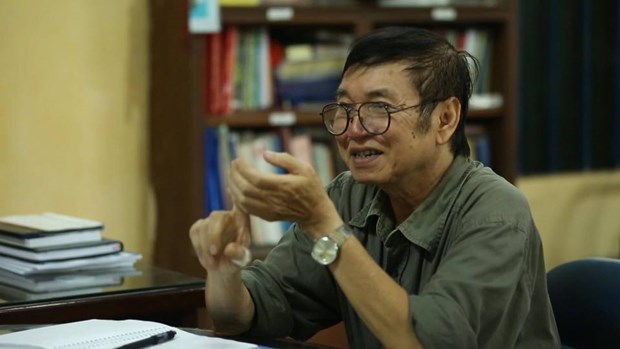 Life & Style
Life & Style

HÀ NỘI — Composer Thao Giang, who had made many contributions to traditional music, especially xẩm singing, passed away on October 24. He was 76 years old.
Musician Thao Giang (born as Nguyễn Văn Vĩnh) was born on July 22, 1948 in Hà Tây, now Hà Nội.
He was awarded the State Prize in Literature & Arts in 2022 for his two pieces of music titled Kể Chuyện Ngày Mùa (Harvest Day Story) and Tình Quê Hương (Love for Motherland).
The musician played đàn nhị (two-string instrument) from a young age, and later studied at the Việt Nam Music School (now Việt Nam National Academy of Music). He was taught by master Vũ Tuấn Đức, a noted musician of Huế royal court.
 |
| Composer Thao Giang. — Photo courtesy of Hà Thu |
In 1967, Giang graduated from the đàn nhị instrument department and then worked as a teacher at the academy. He then was among the founders of the academy’s Traditional Instrument Faculty.
In 1974, Giang published a book titled Method to Learn Đàn Nhị, which was then used as a crucial course book at the faculty. He is the teacher of various famed artists like Thế Dân, Đình Nghi, Sĩ Toán and Văn Hà.
Giang has also composed various pieces of music for đàn nhị like Tình Quê Hương, Làng Ven Sông (Village by a River) and Đan Lưới (Knitting fishnet).
He has also composed music for other traditional instruments like Hương Rừng (Forest Scent) (for 36-string zither), Ao Cá Bác Hồ (Uncle Hồ’s Fish Pond) (for 16-string zither), Du Thuyền Trên Sông Hương (A Cruise on Hương River) (for monochord), and Đường Xa Vui Những Tiếng Đàn (Cheerful music on a long journey) (for 4-string lute).
In 1979, he graduated from university and then studied in India for five years. He then returned to work at the Folk Culture Research Institute and then the Music Institute.
He inspired noted artist Mai Tuyết Hoa to learn the art of xẩm (songs for blind beggars) from elder artisan Hà Thị Cầu.
Artist Hoa said she remembers Giang most when he lost himself watching the film crew filming artists Thanh Ngoan and her singing a xẩm song titled Lỡ Bước Sang Ngang.
“We were performing near Chèm Communal House,” Hoa said. “I remember teacher Giang sweated through. I could not have become a famed artist without his support. I have always highly appreciated his help.”
 |
| Composer Thao Giang (left) and his student Nguyễn Quang Long. — Photo courtesy of Nguyễn Quang Long |
His students in the art of xẩm include artists Khương Cường, Thu Phương, Vũ Đức Huy, Mai Thiện, and music critic Nguyễn Quang Long.
Long considered Giang a major teacher in his life as 20 years ago he encouraged Long to follow xẩm art.
In 2005, Giang established Việt Nam Music Development Centre together with Prof Phạm Minh Khang under the Việt Nam Musicians’ Association. The centre aims to gather, research, train and perform traditional music works.
They made the CD Xẩm Hà Nội, which then went viral among traditional music lovers and established the Hà Nội 36 Phố Phường (Hà Nội 36 Guild Streets) folk music stage (since 2006) and revived the death anniversary for xẩm art’s ancestors (in 2008), when the art was performed in Hà Nội Opera House in a solemn ceremony.
Xẩm singing, a centuries-old Vietnamese art form, has long been regarded as an important piece of the nation’s cultural heritage.
Legend has it that the singing style was invented by Trần Quốc Đĩnh, a son of King Trần Thánh Tông, around 700 years ago, who was kind and had good relationships with the poor. He taught them how to play instruments and sing in order to overcome life’s hardships.
The singing is mainly found in the countryside, expressing optimism and love for the blind. The performances stem mostly from northern regions including the provinces of Ninh Bình, Nam Định, Hải Dương, Bắc Giang and Hà Nội.
During wartime or times of strife, the singers were not able to earn enough locally, so they travelled to find better incomes. Many of them flocked to big cities, including Hà Nội.
Crowded trams, markets and street corners were turned into stages for buskers.
During a xẩm performance, one artist plays a drum, one plays the castanets, one plays a đàn nhị (two-string instrument), one plays a đàn bầu (monochord instrument) and all sing together. To thank and encourage the singers for their performance, the audience offers them money. VNS
 |
| Artists Thanh Ngoan (left) and Mai Tuyết Hoa perform on 'Hà Thành 36 phố phường' stage in 2006. — Photo Courtesy of Nguyễn Quang Long |